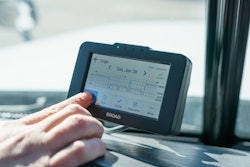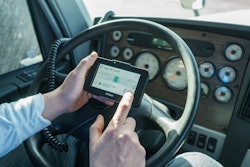
As the end of the year approaches, companies are preparing for the end of an era—the paper logbooks era that is. The practice of truck drivers using paper logs to track their hours of service (HOS) dates as far back as the 1930s, but come December, that system will officially become history.
Beginning Dec. 18, it will be mandatory, per the Federal Motor Carrier Safety Regulations, for fleet operators to have an electronic logging device (ELD) installed in each vehicle they operate. ELDs, which are tablet computers used to record driver HOS, will replace paper driver logs and other systems, including the Automatic On-Board Recording Device (AOBRD).
An ELD automatically tracks, records and transmits:
- Date and time;
- geographic location information;
- vehicle information, including engine hours and miles;
- driver user identification; and
- motor carrier identification.
Currently, drivers are tracking their HOS one of three ways: via paper log, AOBRD or a HOS stand-alone mobile app.
The paper log system requires drivers to fill in their HOS manually and locate a rest stop along their route where they can scan their daily log book. The time it takes to perform this task decreases their productivity while on the road.
While the AOBRD—an electronic unit currently used in some fleets—captures data, including HOS, it does not collect all the information that an ELD tracks and records. If you are a fleet operator with AORBDs installed in your vehicles, operational on or before Dec. 18, your fleet will be considered compliant through Dec. 16, 2019. However, by the 2019 deadline, you will be expected to have upgraded or replaced your AOBRDs to meet ELD status. At that point, only ELD-compliant devices will be recognized as acceptable forms of capturing duty records.
With an HOS stand-alone mobile app, drivers can log their hours via a third-party application on their personal smart phone, which can retain and transmit HOS. This method of capturing HOS is not 100 percent reliable, however, because an app is not part of an integrated, coherent system, and it can experience compatibility-related failures.
ELD Requirements
Enter the ELD Mandate. If you’re wondering whether the ELD final rule applies to you, here’s what you need to know. An ELD is required for:
- Interstate CMV drivers currently required to keep record of duty status;
- vehicles that weigh more than 10,001 pounds;
- vehicles with placarded hazmat loads; and
- vehicles carrying more than eight or 15 passengers, depending on vehicle class.
These requirements encompass the majority of operators. There are some exceptions, which include:
- Drivers who operate within a 100-air-mile radius,
- non-CDL freight drivers who operate within a 150-air-mile radius,
- “drive away tow away” operators, and
- vehicles manufactured before model year 2000.
ELD Benefits & Best Practices
In the food and beverage industry, while not required, it has become an industry best practice to use a telematics system. This is largely due to the Food Safety Modernization Act (FSMA), which has changed the standards when it comes to refrigeration systems and transporting foods. These new standards require extremely precise cold chain tracking and accountability. The connectivity that comes from utilizing a telematics device is what enables fleet managers and their customers to monitor the temperature of vehicle where goods are being stored, and ensures they are within the approved range for the type of product. This gives proof of clear custody and control of the product if questions surround the integrity of it.
Other general benefits to using ELDs, irrespective of the industry, include improved safety and performance, increased efficiency for drivers and carriers, reduction in form errors, and estimated paperwork savings of $705 per driver each year.
Outsourcing the Burden
While there are many advantages, it’s important to be aware of the challenges that go along with ELD implementation. It’s critical to allow ample time to prepare for this mandate, which can vary depending on the type and size of your business. From the selection and purchase of equipment, to installation and testing, employee training, and practice sessions, there are numerous elements to consider if you want to ensure compliance and avoid late penalties.
This is an undeniably time-consuming and costly undertaking. The ELD mandate is essentially pushing every company to act like a commercial carrier, making transportation more complex for small to mid-size businesses. And the reality is that most just aren’t ready. Currently, there are more than 20 ELD platforms available in the market. In addition to the overwhelming number of options, businesses have to invest a large sum of money in purchasing these units—cash that is not likely readily available. Additionally, each driver is required to have his or her own ELD account, and while some units are portable, not all are, further exacerbating the cost.
The greatest burden falls on businesses using vehicles for short-term rental needs (i.e. breakdowns or seasonal upticks in demand). These businesses could be using up to three different ELD platforms at a time, which can be daunting and impact productivity. While short-term renters will have an eight-day exemption, allowing them an eight-day period to use a paper log instead of an ELD, many argue it’s not enough time.
So if you’re asking yourself, “How can I possibly pull this off on my own?,” now might be the time to consider outsourcing to a third party provider like Ryder, which has made capital investments in ELD technology so you don’t have to. If you turn to a transportation and logistics provider for dedicated transportation, you can relieve the pressures related to ELD implementation and compliance and save up to hundreds of dollars a year in fees and hardware costs.
By combining professional drivers, IT engineering for routes and scheduling, best-in-class safety, and advanced vehicle technology, a dedicated transportation solution takes the guesswork out of managing your transportation network and allows you to focus on your core business. If you want to have confidence in knowing that your dedicated fleet is safe, compliant, integrated into your operation, and continuously delivering, outsourcing may just be the answer you’re looking for.

















